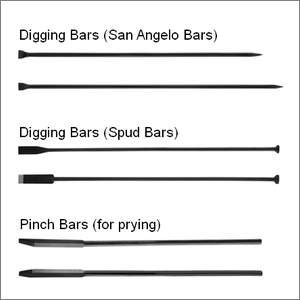Digging in Soil with Rocks and Roots
Author: Greg Baka

The shovel you started with may need to be supplemented by a "digging bar" when you hit a patch of unexpected rocks. Or an axe or mattock may be needed when you uncover large roots. It is best to have tools for each of these conditions on hand when starting a new digging project. That way, no matter what you uncover, you will be prepared.
See our latest guides:
Hand Digging: The Practical Approach
and also
Common digging tools and their uses:
Shovel
These are round-point diggers that have a broad scoop, a sturdy dished blade, and either a short or long handle. These are also called "Combination Shovels" since they can be used for both digging and scooping.
Spade
These are square-edged, flat-bladed digging tools with either a short or long handle. The straight blade is designed to allow you to stand upright while using your body weight to push the blade down into the ground. They are most commonly used for gardening and landscaping work.
Grub Hoe
These are for chopping up sod, tilling garden soil, and sometimes for trenching. They have a strong head that is heavy enough to allow good soil penetration. They come in 4 inch and 6 inch widths, with long sturdy handles.
Mattock
These are heavy-duty tools designed to dig through soil, rocks, and roots. There are two versions, but both have a 2 to 4 inch wide digging blade on one end for breaking up soil. A pick mattock has a sharp pick point on the back end for breaking and moving small rocks. A cutter mattock has an axe blade on the back end for cutting through roots.
Pick or Pickaxe
These are heavy-duty tools designed to break up rocks, compacted gravel, and even concrete. Picks have short 36" handles and heavy steel heads (4 to 7 pounds). They usually have two ends, with one being a sharp pick point. The other end can be either a chisel shape or another pick point. These tools can also be used for prying rocks out of the ground, after they have been loosened.

Digging Bars
There are two types: San Angelo bars and Spud bars. Both are a long (4 to 6 foot) heavy metal bar that is slammed straight down into soil to break it up. San Angelo bars are intended for rocky soil, since one end is a sharp point and the opposite is a chisel. Spud bars are used for chopping roots and for digging post holes. The blade end can loosen soil and chop roots, while the opposite end is a tamper for packing soil around fence posts. Neither is meant for heavy prying! (see Pinch Bars below)
Pinch Bars
These are basically long of pry bars, usually 4 to 5 feet long. They have a tapered, wedge-like end used to penetrate tight spaces. Some are straight, while others have a curve at one end that increases the leverage. They can be used for moving rocks, prying apart concrete, and even for ripping apart stumps.
Axes and Hatchets
These are single-bladed tools for cutting wood and roots. A hatchet is short for one-handed use, while an axe is long for two-handed use. Using them in soil can quickly damage them, so cheap models are best.
Is your soil good, rocky, or root-y?
Tools for good or average soil
Good soil is fairly free of rocks, compacted gravel, and large roots. For digging purposes, it doesn't much matter if it is clay, loam, or sandy. Although a heavy clay soil will be more difficult than a light sandy soil.
A typical round-point shovel is great for this type of soil, and for many of the small around-the-house digging projects. Such as adding plants into a flower bed, planting a bush or tree, or digging out a space for a patio or fire pit. While a spade will work better for certain gardening or landscaping projects like spading the soil or edging flower beds.
Grub hoes are great for projects that require you to loosen large areas of soil to a shallow depth. They are also especially good for trenching projects due to their ability to break deep soil and drag it up and out of the trench.
If your soil hardens due to lack of moisture and a high clay content, a mattock will come in handy to break through the hard layers.
Specialty digging tools like post hole diggers and augers will also work best in good soil. Rocks and roots will stop post hole diggers real quick.
Tools for rocky soil or hard-packed clay

A pick mattock has the heft and physics to break apart the toughest ground. The pointed can also penetrate between and around rocks to allow you to pry them from the ground. Remember to use both ends. With the blade end, loosen and move soil aside to expose more rocks. Then with the pointed end break and loosen around the rock to make it easier to pry out.
A digging bar is really useful, but not many people know about them. The San Angelo style bar is the one you want for busting loose rocks and breaking up hard clay and subsoil. It has two working ends, one end pointed and the other end with a narrow chisel blade. It is used by plunging it straight down into the ground, then wiggling it around to loosen up surrounding soil and stone. Keep stabbing and wiggling until there is enough loose soil and rock for you to scoop it out with a shovel or post hole digger.
Remember that a digging bar is ONLY for stabbing and wiggling, NOT for prying. You do not want to bend this long bar. When you come across the inevitable rock that is too large to easily move, use a pinch bar to pry it. Since a pinch bar is a basically an extra-long crowbar, it is built for heavy-duty levering and prying.
Tools for digging through roots

If your hole is shallow, a cheap hatchet works well. If the root is really big, a saw may be the easiest thing to use. Limbing saws have the right shape and teeth to cut roots, as does an electric Sawz-All with a long coarse blade. Be aware that soil does quickly wear out saw, axe, and hatchet blades.
But for most digging jobs in root-infested areas, the Cutter Mattock and the Spud Bar will be what you want. As mentioned above for the pick, you will find that the cutter mattock is best for shallow digging (less than 9 inches deep), while the spud bar is best for deeper holes.
A cutter mattock has the weight and design to break apart the toughest soil. The axe end can also chop through the roots that your shovel is stopped by. Remember to use both ends. With the blade end, loosen and move soil aside to expose more roots. Then with the axe end cut the root at the edge (or both edges) of the hole.
The type of digging bar that is best for roots is called a Spud Bar. One end of this long tool is a wide sharp blade. Keep it sharp for easy root cutting. It is used by plunging in straight down into the soil or onto a root. It will take multiple hits to cut larger roots.
Remember, do NOT pry with a spud bar. It is not built for that. Prying roots rarely works anyways, but if you need to, use the mattock or a pinch bar. Also note that there are spud bars made specifically for ice fishermen. You do not want to buy an ice-fishing model for digging work.
You may find once you have removed soil from around a root, that it is no longer held firmly in place and moves away when you strike at it. A solution for smaller roots is to use cheap loppers or pruners to cut them.
Conclusion
A digging project always requires effort and muscle, but with the right tools you can make it easier. When a project is coming up, first go dig a test hole in the target area. If you find roots or rocks, then go get a matching mattock or digging bar. You don't need all the tools at once, just the ones that will be best for your hole's depth and obstructions. These type of tools last a long time, so eventually you will acquire a great collection.
Click to learn about our:
ARTICLES ABOUT DIGGING AND TRENCHING

Author: Greg Baka is the founder of EasyDigging.com
He is also an experienced gardener and home remodeling DIY'er. He has tackled everything from underground drainage to metal roofing, and all things in between. Using his engineering degree, he designed a variety of construction and excavating equipment.
Check out our Gardening and Digging Tools!
EasyDigging.com sells a variety of heavy-duty tools for gardening, landscaping, construction, and small-scale agriculture.
Just click one of the product types in the green menu above...▲
Check out our Gardening and Digging Tools!
EasyDigging.com sells a variety of heavy-duty tools for gardening, landscaping, construction, and small-scale agriculture.
Just click HERE to shoot back up to the top of the page, then open the "Product Menu" in the big green bar.
